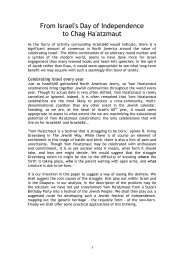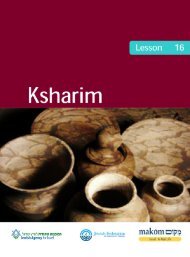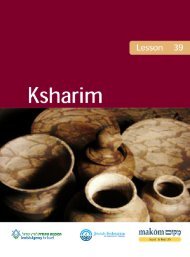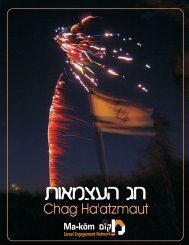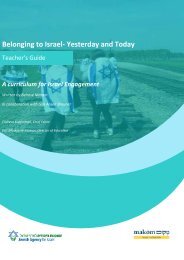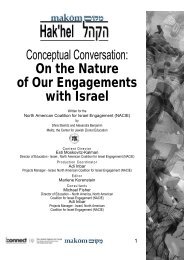- Page 5 and 6: do those things, but they are not e
- Page 7 and 8: The first third of the course deals
- Page 10 and 11: 1. Is it the land that is special,
- Page 12 and 13: portion of American Jewish leadersh
- Page 14 and 15: a. Israel is a holy land, God’s p
- Page 16 and 17: 4. Preparation for Teaching Israel
- Page 18 and 19: 18 Review and reflection:teaching B
- Page 20 and 21: e. Niels Bohr to Werner Heisenberg,
- Page 22 and 23: http://www.lib.utexas.edu/maps/midd
- Page 24 and 25: KATZRIN BEERSHEBA JERUSALEM TEL AVI
- Page 26 and 27: 1. a: Deuteronomy - history is nati
- Page 28 and 29: 2. Some ideas about Jewish historya
- Page 30 and 31: k. Nachman Krochmal, Guide for the
- Page 32 and 33: A Peace Now survey of residents of
- Page 34 and 35: ii.iii.Additional reinforcements of
- Page 36 and 37: 5. It is interesting to think about
- Page 38 and 39: permanent abode in Seir - Jacob to
- Page 40 and 41: These are only suggestions; there a
- Page 42 and 43: c. The page of “Galut” sources
- Page 44 and 45: 6. Galveston Movement:http://www.ts
- Page 46 and 47: 2And God spoke to Israel in a visio
- Page 48 and 49: L e s s o n 7:Egypt, Exodus & Sinai
- Page 50 and 51: Israel grew to form a multitude of
- Page 52 and 53:
kingdom of priests.” They are cha
- Page 54 and 55:
The purpose of our freedom and nati
- Page 56 and 57:
5. Possible Methodology:a. The abov
- Page 58 and 59:
included such groups, but these wer
- Page 60 and 61:
Eretz Israel was the birthplace of
- Page 62 and 63:
4. Expanded Outline:a. Introduction
- Page 64 and 65:
entering and settling the land. The
- Page 66 and 67:
that support the explanation put fo
- Page 68 and 69:
5. Rashi Leviticus 1:1: “Saying
- Page 70 and 71:
will say “If the land was truly c
- Page 72 and 73:
10. There are a number of modern Is
- Page 74 and 75:
what must have been the major obsta
- Page 76 and 77:
Letter 287:“My beloved and honore
- Page 78 and 79:
Discussion Questions: What do we do
- Page 80 and 81:
Deuteronomy 21 - the law of the red
- Page 82 and 83:
L e s s o n 10:The Covenant, the La
- Page 84 and 85:
c.Does the modern state fit the bib
- Page 86 and 87:
Excerpt from paper by Aviezer Ravit
- Page 88 and 89:
those bounds, they could work to
- Page 90 and 91:
to live according to the norms of t
- Page 92 and 93:
iv. The concept of bal tashchit: De
- Page 94 and 95:
. Or…c. Or…i. What’s so speci
- Page 96 and 97:
Talmud Baba Kama 80a[Referring to M
- Page 98 and 99:
Zalman Shazar, Morning StarsSuddenl
- Page 100 and 101:
L e s s o n 12:Conquest and Coexist
- Page 102 and 103:
(a) Discuss: how do we present the
- Page 104 and 105:
invaders forded the Jordan and, aft
- Page 106 and 107:
Military Aspects of the ConquestEve
- Page 108 and 109:
frontal assaults upon Canaanite for
- Page 110 and 111:
L e s s o n 13:The Creation of the
- Page 113 and 114:
•Note the fulfillment of Samuel
- Page 115 and 116:
anoints him king. Although there is
- Page 117 and 118:
to elevate David publicly while pri
- Page 119 and 120:
3. Some modern songs about David:מ
- Page 121 and 122:
דוד דוד מלךדוד דוד
- Page 123 and 124:
אני עולה לירושליםמ
- Page 125 and 126:
a. The empire at its peak: As a fol
- Page 127 and 128:
Solomon. Syncretism, corruption, pa
- Page 129 and 130:
Tiglath-Pileser III's Campaigns 068
- Page 131 and 132:
Across the Sabbath River is the com
- Page 133 and 134:
d. Awareness of the possible meanin
- Page 135 and 136:
Why do the kings of Judah repeatedl
- Page 137 and 138:
from the Warsaw ghetto, among other
- Page 139 and 140:
L e s s o n 16:The Messiah[See meth
- Page 141 and 142:
much longer before the end. If it i
- Page 143 and 144:
ii.iii.How could we keep the expect
- Page 145 and 146:
There were 80,000 trumpeters besieg
- Page 147 and 148:
Sir Paul Rycaut, 1666And now all th
- Page 149 and 150:
ii.assumed to have been written aft
- Page 151 and 152:
odds with the descendants of Judah
- Page 153 and 154:
For a good, concise summary of this
- Page 155 and 156:
4. Expanded outlinea. Sacred spacei
- Page 157 and 158:
these questions, to try to clear up
- Page 159 and 160:
This is a radical departure from ac
- Page 161 and 162:
6. Yehuda Halevi, “Ode to Zion”
- Page 163 and 164:
c. Yi-Fu Tuan, TopophiliaThe small
- Page 165 and 166:
3. Lesson goalsa. Basic understandi
- Page 167 and 168:
iv.the Jews of Eretz Yisrael in an
- Page 169 and 170:
vi.Here is the place to mention the
- Page 171 and 172:
Why Chanukah?1. Talmud, Shabbat 21b
- Page 173 and 174:
L e s s o n 20:Palestine under Roma
- Page 175 and 176:
The Jews of Ancient Rome, JPS 1960
- Page 177 and 178:
living in the God-given land, or li
- Page 179 and 180:
ecause it is liable to cause them t
- Page 181 and 182:
said: Indeed, you were worthy to ha
- Page 183 and 184:
Lesson 21:The Great Revolt1. Outlin
- Page 185 and 186:
crowned emperor. When Vespasian’s
- Page 187 and 188:
the internecine strife within the b
- Page 189 and 190:
governance that was stable in the a
- Page 191 and 192:
Read the excerpt from Bialik's essa
- Page 193 and 194:
L e s s o n 23:Israel and Babylonia
- Page 195 and 196:
Can we think of modern-day parallel
- Page 197 and 198:
Many issues are decided differently
- Page 199 and 200:
Sources1. Mishnah Rosh Hashanah 2,
- Page 201 and 202:
L e s s o n 24:The Jewish Calendar1
- Page 203 and 204:
Questions for discussion: Do the tw
- Page 205 and 206:
k. The Set Calendarand one in Cairo
- Page 207 and 208:
SourcesHaredim operate almost solel
- Page 209 and 210:
when the Temple still stood, they c
- Page 211 and 212:
חוק יום הזכרון ליצח
- Page 213 and 214:
L e s s o n 25:High Holidays1. Outl
- Page 215 and 216:
A cute activity you can try if you
- Page 217 and 218:
Appendix - Jewish Israelis by count
- Page 219 and 220:
He then came to the scapegoat and l
- Page 221 and 222:
Will be different and beautiful.On
- Page 223 and 224:
Meanwhile, if you drive around the
- Page 225 and 226:
Pomegranate:http://urj.org/Articles
- Page 227 and 228:
There is evidence that in Mishnaic
- Page 229 and 230:
L e s s o n 27:Tu Beshvat1. Outline
- Page 231 and 232:
v. Suggestions for classroom activi
- Page 233 and 234:
iii.iv.By 1913, the tradition was s
- Page 235 and 236:
Sources1. Mishna Rosh Hashanah Chap
- Page 237 and 238:
כי תבאו אל הארץ ונט
- Page 239 and 240:
In Israel, Tu Beshvat is a time for
- Page 241 and 242:
כך גם אירע לט"ו בשבט
- Page 243 and 244:
10-11: Esther is sent by her cousin
- Page 245 and 246:
Could it be that the laughter of Pu
- Page 247 and 248:
L e s s o n 29:Pesach1. Outlinea. T
- Page 249 and 250:
itself - but also - for the first t
- Page 251 and 252:
Sources1. Mishnah Pesachim 10:4 acc
- Page 253 and 254:
This Passover seder nightIs the nin
- Page 255 and 256:
On a high hill,A shepherds' flute s
- Page 257 and 258:
L e s s o n 30:Yom Hashoah1. Outlin
- Page 259 and 260:
faces, so the boy realizes that the
- Page 261 and 262:
- Israel's determination to manufac
- Page 263 and 264:
7.As a 10 year old I was taken to A
- Page 265 and 266:
Jefferson, one of the founding fath
- Page 267 and 268:
epresentatives in the Tel Aviv Muse
- Page 269 and 270:
at each cemetery where soldiers are
- Page 271 and 272:
24,000 students of Rabbi Akiva in a
- Page 273 and 274:
Sources1. The Declaration of the es
- Page 275 and 276:
WE APPEAL — in the very midst of
- Page 277 and 278:
And the two will then sayWith soft
- Page 279 and 280:
offerings and your sacrifices of we
- Page 281 and 282:
interpretation, the phrase in verse
- Page 283 and 284:
(Note: this illustration is from a
- Page 285 and 286:
This celebration attracts in partic
- Page 287 and 288:
L e s s o n 33Shabbat in Israel1.Ou
- Page 289 and 290:
15. Throughout the pre-state period
- Page 291 and 292:
And some interesting numbers:A Port
- Page 293 and 294:
pulled them farther and farther dow
- Page 295 and 296:
11. Sacrifices, really?The question
- Page 297 and 298:
elationship to the land of Israel.
- Page 299 and 300:
However, these days have been treat
- Page 301 and 302:
the wilderness of the Red Sea," etc
- Page 303 and 304:
e my people" (Lev. xxvi. 12). But t
- Page 305 and 306:
DefinitionPercentageUltra-Orthodox
- Page 307 and 308:
e. Bar MitzvahThe bar mitzvah cerem
- Page 309 and 310:
The Western Wall is run by strictly
- Page 311 and 312:
Sources1. Bar-what? Yossi Amir, Kib
- Page 313 and 314:
L e s s o n 36Youth and coming of a
- Page 315 and 316:
emedy these social ills. In any cas
- Page 317 and 318:
een in the past decade). See, on th
- Page 319 and 320:
service. While the majority of kids
- Page 321 and 322:
(Goal 6) - army service, especially
- Page 323 and 324:
Combat unit 55%Administrative unit
- Page 325 and 326:
4. Raising students' consciousness
- Page 327 and 328:
Galilee Diary #11; February, 2001Ma
- Page 329 and 330:
school - two years of army service
- Page 331 and 332:
a. References to Israel in the Marr
- Page 333 and 334:
do not travel abroad for this reaso
- Page 335 and 336:
for all couples within the bounds o
- Page 337 and 338:
L e s s o n 37Marriage1. Outline:d.
- Page 339 and 340:
and meaningful this is the Talmud l
- Page 341 and 342:
effect a financial agreement betwee
- Page 343 and 344:
chance that many would be classifie
- Page 345 and 346:
you…. And from the day that the T
- Page 347 and 348:
16. Babylonian Talmud, Tractate Bra
- Page 349 and 350:
L e s s o n 38Women in Israel1. Out
- Page 351 and 352:
components of the rural settlement
- Page 353 and 354:
6. Altogether, at the beginning of
- Page 355 and 356:
significant efforts to do so. A de-
- Page 357 and 358:
These sources of marginalization al
- Page 359 and 360:
Another example of successful femal
- Page 361 and 362:
This is what she wrote about that w
- Page 363 and 364:
Additional resourcesTeaching tool:
- Page 365 and 366:
eserved for the wealthy - but inter
- Page 367 and 368:
“belong” to a synagogue, and th
- Page 369 and 370:
Sources and references:General:http
- Page 371 and 372:
Yehudah Amichai, “Tourists”They
- Page 373 and 374:
Goals:1. Familiarity with medieval
- Page 375 and 376:
2. The Kabbalists of SafedOne of th
- Page 377 and 378:
Gershom Scholem, sees a clear conne
- Page 379 and 380:
cook in someone else’s home, and
- Page 381 and 382:
Shekhinah dwelt there nine hundred
- Page 383 and 384:
2. A Longing to Return to the Land
- Page 385 and 386:
He will restore you with mercy and
- Page 387 and 388:
Rabbi Nachman of Bratslav used to s
- Page 389 and 390:
L e s s o n 41The Origins of Zionis
- Page 391 and 392:
in opportunity for livelihood. Most
- Page 393 and 394:
encouraging Jewish unity through an
- Page 395 and 396:
Most of these writers hailed from t
- Page 397 and 398:
successfully in a pluralistic Hapsb
- Page 399 and 400:
land of Egypt."" Respect and benevo
- Page 401 and 402:
When the Israelites were totally di
- Page 403 and 404:
elders of each district, men of pie
- Page 405 and 406:
spiritually as a nation. The world
- Page 407 and 408:
must first of all establish it as a
- Page 409 and 410:
explicitly sought to replace Jewish
- Page 411 and 412:
•This was indeed the ideological
- Page 413 and 414:
society. The solution can be seen a
- Page 415 and 416:
what does he mean coming to us talk
- Page 417 and 418:
But Jewish secular nationalism is a
- Page 419 and 420:
Socialism will bring the same disap
- Page 421 and 422:
where it will be able to live a lif
- Page 423 and 424:
convenient trigger for the discussi
- Page 425 and 426:
iver, and people from Eretz Yisrael
- Page 427 and 428:
them young. All faces fearful, ever
- Page 429 and 430:
http://israel.poetryinternational.o
- Page 431:
egular work, and second, when we do



